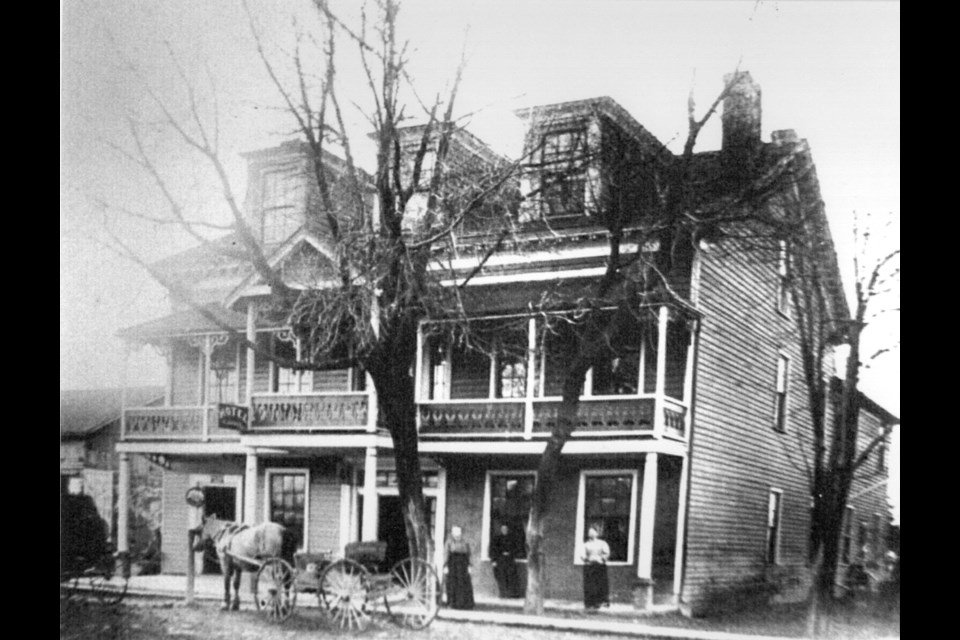Allanburgh, lying midway between Thorold and Port Robinson, is a pretty little village, the history of which has been contemporaneous with that of the latter place.
A little north of the village was the Black Horse Tavern, the oldest inn situated in the county. The exact date of its first building is unknown; but situated at the intersection of important roads, it is probable that a hotel stood on the site at a very early date. It is said that some Indians had a log wigwam at this place, and that the tavern took its name from a black horse that the old chief rode, but for this, the chronicler cannot vouch.
In the early years of the 20th century, it was known as Badgley’s Inn, being kept at that time by Joseph Badgeley. The main road from Niagara Falls to Windsor ran past this place, and when Western Michigan was being opened up, the Black Horse Tavern was the stopping place for those who were going from the Eastern States to make homes in the new lumber region. During the time of this emigration, eight or 10 wagons containing settlers’ property might commonly be seen at the old inn, where the travellers rested for the night.
The village proper was built on the Vanderburgh farm, although the Uppers, whose property lay a little farther north, have always been identified with the interests of the place.
Most of the early settlers in this vicinity were Dutch Loyalists. The first road laid out was an irregular one connecting the farms of the Boukes, the Uppers, the Vanderburghs and the Wilkersons, and was known as the “Holland Road,” which later led from Allanburgh to Lundy’s Lane.
In the history of the Welland Canals, Allanburgh has been an important point; for the first sod of the old canal was turned at this village, and here the new waterway joins the old one.
From the time of the canal agitation until navigation was opened, this work was the all-absorbing topic. While the rest of the country was occupied with discussions about the Family Compact and other political abuses of the day, Lincoln County was divided chiefly into two parties—the pro-canal men and the anti-canal party.
Naturally, the frontier people, and especially those interested in the portage company, were opposed to Merritt’s scheme; but even among those who afterwards benefited by the canal there were a few who objected to it, because it was something new. Their views changed, however, as soon as excavation began upon the Deep Cut, for at once Allanburgh and its neighbourhood became a centre of business.
All along the Deep Cut, where well-sodded banks had cattle grazing, there was then a row of shops and lodging houses—poorly-built shanties, it is true, but still representing the wonderful change that had taken place in the population.
The Canal Company had a general store, and there were three or four other shops on the bank that sold goods of all kinds. There was also a market at the Deep Cut, and so great was the demand for farm produce that some farmers sent wagons there twice a day, with fruits, vegetables, eggs and butter.
Within the village of Allanburgh two of the oldest shops were those kept by Andrew Vanderburgh and Samuel Swayze.
It was some mills built by an American capitalist that practically gave life to the village. This man, the Hon. J. B. Yates, built a grist mill, a sawmill and a shingle factory in Allanburgh in 1835. He was represented in the place by his agent, John G. Stockley. These mills were afterwards owned by several different firms, including that of James McKee and Jacob Upper, while Baruch Tucker and John Rennie were partners in the business for 30 years. The Canal Company also owned the property at one time, and then the government bought it. The mills were destroyed when their sites were needed for the enlargement of the new canal.
It was Stockley who gave the village its name, calling it after Allen, a member of the Canal Company.
Among the many industries that the village once possessed were Duncan & Wright’s flour mill, Bowman’s pail factory, Hoover & Vanderburgh’s sawmill, Harper’s bakery, Philip Bump’s tannery, Thomas Towers’ foundry and Williams’ wheelbarrow factory, while James Brodhead manufactured scythe snathes. John Brown regularly employed between 20 and 30 persons in his shipyard.
Allanburgh has contained also eight taverns, two shoe shops, two tailor shops, a brickyard, two blacksmith shops, two cabinet shops, two woolen factories, a dye-house, two wagon shops and a factory in which grain candles were made.
In the curiosity line, Allanburgh has produced the biggest horse that the world has ever seen.
In 1849, the population numbered 300. At one time it must have been larger, for the village school has had as many as 110 pupils attending the classes.


